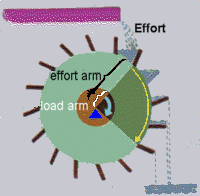 SKC Films Library SKC Films Library |
| SKC Films Library >> Technology >> Mechanical Engineering >> Machines In General |
| The Wheel and Axle The ancients realized that the weight and effort in a lever were capable of describing a circle around its fulcrum. When they finally invented a lever that could rotate the full 360° of the circle, they had discovered the second of the six basic machines. The most obvious uses of the wheel and axle are bicycles, automobiles, and other modes of transportation, as well as the ferris wheel, wind mill, and conveyor belts. But the remarkable versatility of this basic machine is best revealed by the various ways the principle is embodied in many familiar devices not normally considered wheels -- a screwdriver, a water faucet, a key in a keyhole, etc..
The wheel and axle is a first-class lever. The center of the axle corresponds to the fulcrum. The radius of the axle corresponds to the load arm. The radius of the wheel corresponds to the force, or effort, arm to which force is applied. Sometimes a crank is used instead of a wheel. In the water wheel illustration at left, the water is the effort, the wheel's radius is the effort arm, the force the millstone exerts on the axle is the resistance (load) and the axle's radius is the resistance arm. The Advantage of a Wheel and Axle Just as with a lever, the amount of exertion depends on the ratio of two lengths: that of the radius of the axle to the radius of the wheel. Thus, a 10-inch wheel on a one-inch axle magnifies force by 10. A 10-foot wheel on the same one-inch axle magnifies by 120. And, just as levers can be operated by other levers, so the mechanical advantage of the wheel and axle can be stepped up by using a series of geared wheels of different sizes. The diagram at right shows a motor turning a large wheel which turns a small one. As the larger turns 120° (shaded area), the smaller completes a whole turn. The large wheel's speed of rotation is magnified three times. PRINT SOURCES SEE ALSO |
| SKC Films Library >> Technology >> Mechanical Engineering
>> Machines
In General This page was last updated on May 19, 2017. |

 How the Wheel and Axle Work
How the Wheel and Axle Work